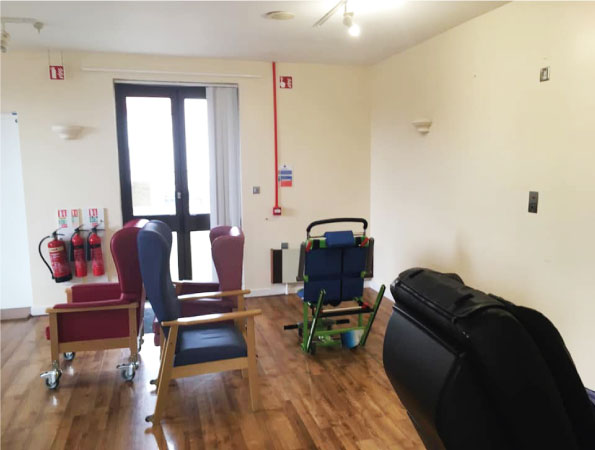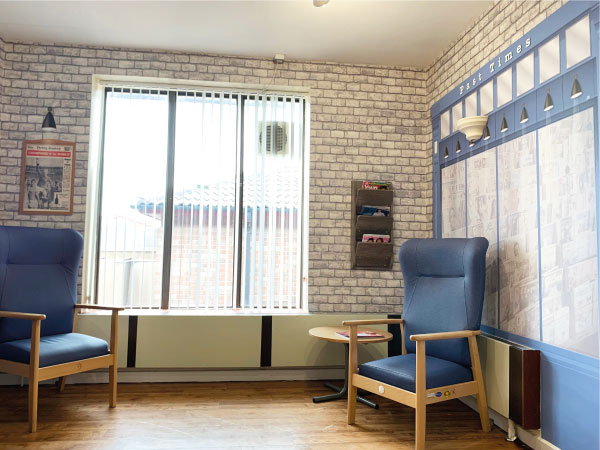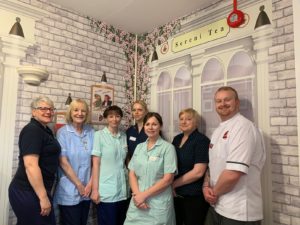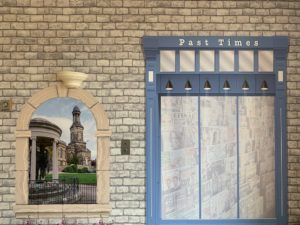10 April 2019
Ward staff and dementia specialists at the Royal Shrewsbury Hospital (RSH) have joined forces to transform an uninspiring day room into a town square complete with a café, newsagent and views of St Chad’s Church.


The ‘Shrewsbury Scene’ has been created in a space on Ward 21 which was (previously used as a discharge area. The makeover has been completed with scenic wallpaper, murals and multi-functional areas, bringing colour, stimulation and entertainment for patients staying in the hospital.
In one corner of the room, a ‘newsagents’ will been created with up-to-date magazines as well as old newspapers and publications for patients to read. A tea shop, named ‘Sereni Tea’ by staff, will have tables, seating and drinks machines, providing an area for patients to relax with their families, friends or carers and to eat and have drinks. Comfortable armchairs and a television will allow people the time to relax away from their beds.

Karen Breese, left, with staff on Ward 21
The Shrewsbury Scene is located in Ward 21, which cares for predominantly older people who are frail and have suffered a stroke. Many of them also live with dementia. The improvement work was jointly funded by Ward 21 and the Dementia Team at The Shrewsbury and Telford Hospital NHS Trust (SaTH), which runs RSH.
Karen Breese, Dementia Clinical Specialist, said: “We are so happy with the results. We’re always working to improve care for people in our hospitals living with dementia, and we are proud to have created a space that get patients up and moving around and that will help with their mental wellbeing and physical recovery.”
Jude Evans, Ward 21 Clerk, added: “As well as improving the environment for our patients, the transformation of our discharge area into Shrewsbury Scene is about engaging carers and supporting people to have a better experience.
“Work will continue in the coming months as the garden is given a makeover and activities are installed for patients.”
The Shrewsbury Scene is the latest of a number of initiatives aimed at making life better for people living with Dementia. Others include:
- Dementia-friendly mugs and plastic tumblers playing pre-set messages to patients not drinking regularly enough.

- Dementia Dolls, which when used in the right way, and given to the right patient, can have a phenomenal impact. They can bring back happy memories of parenthood and help people have a role to nurture and care. It can also improve communication and confidence.
- Twiddlemuffs, thick hand muffs with bits and bobs attached to the inside and out which are designed to provide a stimulation activity for restless hands for patients with dementia.
- Snack boxes, to provide small amounts of fresh finger food over a 24-hour period to supplement regular meal times. In the later stages of dementia the most important thing is making sure a patient takes on a higher-calorie diet as appropriate to their need.
- Blue crockery, provided following research at the University of Stirling that shows it is easier for patients living dementia to distinguish what food they are eating when it is presented on a blue plate opposed to a white plate.
- The Butterfly Scheme, which uses a butterfly symbol to quickly and discreetly identify patients with dementia or confusion.
- The Carer’s Passport, encouraging carers to visit and stay with patients living with dementia in order to provide reassurance, support, and help with eating and drinking and other day-to-day activities.
- This Is Me, a leaflet that people living with dementia can use to tell staff about their needs, preferences, likes, dislikes and interests.
- John’s Campaign, an initiative towards the right to stay with people with Dementia in hospital.
